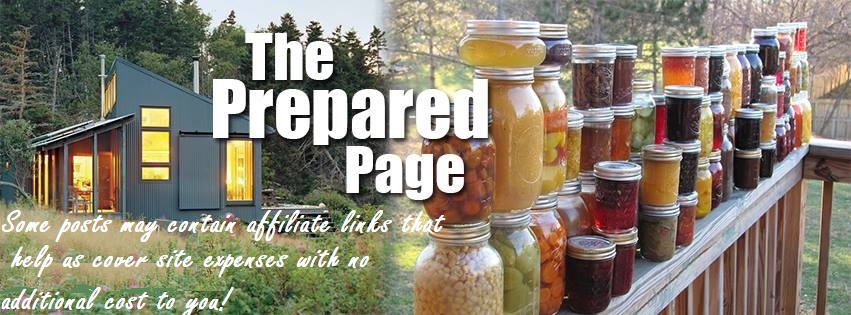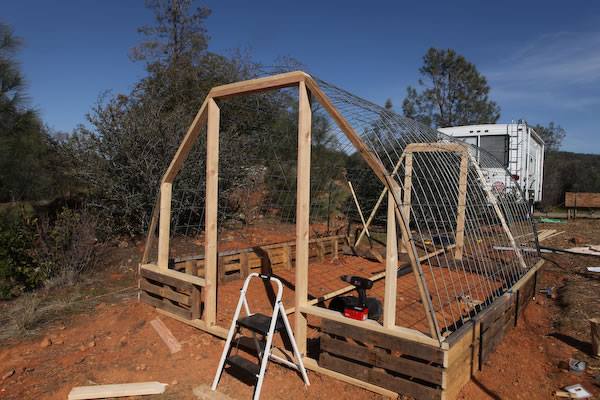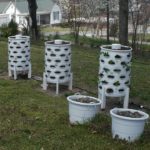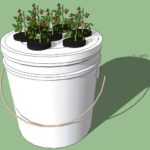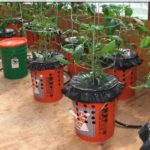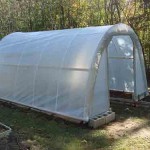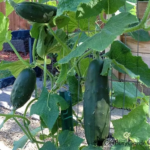DIY Pallet Greenhouse
Having a greenhouse can be an invaluable tool in your garden, as it opens up many different growing possibilities, and can be a huge season extender in areas where the number of good growing days is limited. Greenhouses make it easier to get new seedlings started and help to protect plants from spring and fall frosts. They are a wonderful addition, bu…t can be expensive to put in, and there are a few things to consider before building one.
A lot of thought and planning went into the design and construction of this Greenhouse. With cost being one of the number-one constraints for the project, our research gave us an idea to use what we had on hand – pallets, cattle panels, and a bit of new materials to give it good rigidity. We ended up with a Quonset/High-Tunnel-style greenhouse. Estimated Final Cost: $300.00 Final Dimensions 9′ x 12.5′
The size of greenhouse was largely determined by the construction materials on hand. The big decision for us was how many cattle panels to use. For reference, the panels we had available are 50 inches tall and 16 feet long. We originally were only going to use two panels, but one rule of greenhouses is that you always go bigger that you think you need or want, so we went with three panels. This gave us 12.5′ as the length of our greenhouse. (Plenty long for a small homestead. Big enough for our growing needs.) Then for the width we determined that 9′ as the base of our arch gave us about 6.5′ of head room once we placed the panels on the mini 13″ pallet foundation. You can make the width as wide or as narrow as you like, keeping in mind that too wide a span will not have enough tension in the arch to support itself and a ridge beam will be needed.
After viewing the aftermath of high winds on tarps for cattle panel goat shelters, and hearing stories of people chasing their plastic down the field from their PVC high tunnels, we knew that special consideration was needed for the storms and winds we get in our area. We had to make sure that the covering was tight and would not tear in high winds. To accomplish this, we planned on using 1″ x 2″ wood strips to pull the plastic tight and secure it. We also added protective end caps (made from 1/2′ pipe insulation) on the cattle panel to protect the plastic from puncture holes.
There are basically three types of plastic film that can be used for a greenhouse. The choices are: 1) a single-season non-UV 6 mil plastic from home depot or other local hardware store, 2) a UV stable 4-year greenhouse plastic, and 3) a re-enforced UV stable greenhouse plastic. The home depot type plastic is very cheap but is really not designed for use on greenhouses and breaks down rather rapidly and can become a huge mess to deal with once it gets trashed. We ended up using the basic 4-year greenhouse plastic and used a special discount coupon from a local farm supply store to purchase the plastic. We were able to cover all surfaces with a 20′ x 20′ piece.
With the base of the greenhouse being constructed out of mini pallets, we were able to incorporate base venting into our greenhouse. We had also planned a front door and a back zip-up door, but ended up not using the zip door, and instead added an automatic vent opener and window in the rear of the greenhouse.
First we selected our spot and leveled the foundation. We were working with a sloping hill, and it took a number of hours to get it level and ready. We used mini pallets to build the base of the greenhouse. We screwed them together, and then carried them out in whole segments to the foundation. Each of the mini pallets measured 13″ in length. For our 12.5′ greenhouse, we used 12 pallets on each side. This gave us a little bit of excess, which we sawed off later.
We applied re bar braces pounded into the ground on the inside with conduit straps to secure the foundation to the ground. Didn’t want the whole structure to fly away one night. Then we added 3′ steel spikes on the outer walls to counter the force of the panels pushing outward.We used a 2 x 2 board as a bracing beam to hold the panels even, and then used fence staples to secure the cattle panel to the base pallets.
Once all three cattle panels were in place, we used bailing wire to secure the panels together and made sure the cut point faced inward as to not puncture the greenhouse plastic. We framed in the front and back end walls. The plastic was then stretched over the ends and secured with 1 x 2 wood strips to the end wall pieces. This made the plastic very tight and secure. After the front and back walls were framed, we added pipe insulation to the ends of the cattle panels as a way to help protect the plastic from the sharp edges of the panels. A ridge beam was added for additional stabilization. We used left over plastic to build the door, which was designed to be open partially or all the way.
In order to secure the plastic along the sides of the greenhouse, the plastic was sandwiched between a 2 x 2 and a 1 x 2. This allows the option of either keeping the plastic on the ground (and covering the pallet vents) or easily propping it up to allow for more airflow on hot days. We then added a rear wall automatic vent opener. The window opens as the heat rises and greatly increases the airflow as it opens.
After building your Greenhouse, you will want to start some Good Heirloom Seeds. Check them out at
Source Danny Look
 This is an aggregated site. Please be aware some of the sites we link you to could have pop ups. We have no control over them. However, we will never link you to a site that requires you to make any purchase to view the blog.
This is an aggregated site. Please be aware some of the sites we link you to could have pop ups. We have no control over them. However, we will never link you to a site that requires you to make any purchase to view the blog.
Please read our disclaimer. We provide you with information from various sites all over the world. The author’s expressed opinion isn’t necessarily that of The Prepared Page or its staff. Our intent is to bring you the information. Use your and your own best judgment when using any information contained within the blogs.
While you’re here check out some of the other posts you may find them interesting!!!
Some posts may contain affiliate links.
